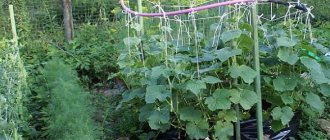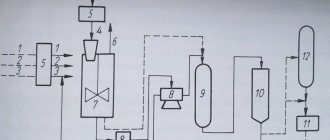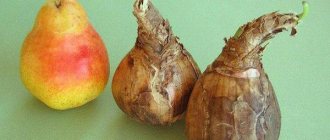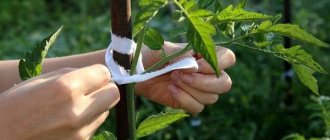Dead hanging is an integral part of every pig farm procedure. This stage involves hanging the carcass and bleeding. If this is not done, blood will penetrate into the meat and lead to spoilage.
The slaughter site should be dry, clean, and, if possible, protected from wind and dust. It is also impossible to slaughter in the immediate vicinity of a pigsty, and not only for reasons of hygiene. The remaining livestock should not see the process itself and smell the blood, so choose an area as far away as possible, behind a solid fence or behind the walls of buildings.
How to electrocute a pig
A separate question, because special stun guns are used for this.
The technique by which pigs are slaughtered requires a little skill and skill. Pigs are slaughtered quite quickly, even faster than cutting them in the neck. When an electrical impulse of 70 to 90 volts is applied, the pig's heart stops. Experts recommend holding the shocker to the body longer in order to ensure that the animal is killed and its heart stops.
Other methods are widely used on an industrial scale
How do they cut at a meat processing plant? Slaughter is carried out in large quantities in slaughterhouses specially equipped for this purpose, where there are special chambers with hooks and chains. An animal slaughter specialist must quickly place a special chain on the animal’s legs, after which the pig is lifted using a mechanism and spins on a special conveyor.
A slaughterer stands at the trial with a sharp stiletto, and with one precise blow he kills the animal with a blow to the heart. The blood that immediately begins to ooze from the wound flows into specially equipped gutters directed into a vat, and there the blood is mixed to prevent it from clotting. The blood is subsequently widely used for the production of food products and medicines.
In a small slaughterhouse, pigs are slaughtered without using a conveyor method. Slaughterers stab pigs in the heart using a special sharp knife.
Useful tips for beginners
For those who are new to pig slaughter, here are some practical tips:
- A blow to the heart should not be used, since this method is more suitable for experienced slaughterers. The point is that you need to know exactly where to stick the knife. For beginners, a hit to the neck is more suitable.
- It is recommended to stun the pig before slaughter.
- For better bleeding, the carcass should be hung on a hook. Remember that blood spoils the taste of meat because it gives it an unpleasant aftertaste.
Before you start slaughtering a pig, you need to thoroughly prepare and take into account all the nuances of this process. An injured and wounded animal not only suffers, but also becomes very aggressive, and the picture of a person running after a bloody creature causes only horror and disgust. In this regard, it is also worth taking care of the moral aspect of the procedure.
0
0
Copy link
Preparation
First you need to determine the optimal time for slaughter. It is not profitable to slaughter a pig before it reaches slaughter weight, which depends on the breed. Large whites gain weight up to 300 kg, so it is advisable to slaughter only after the weight reaches 150 kg and above, but Vietnamese piglets are ready at around 80 kg
It is important to take into account the phase of the reproductive cycle: every 18-20 days, mature females begin to “walk”, at this time a hormonal surge occurs, which adversely affects the quality of meat. It is usually advised to count 10 days after the hunting period
If an adult boar is being slaughtered, it is advised to castrate him two months before the procedure; the reason is hormones unfavorable for the quality of the meat.
Direct preparation of the animal includes two main components: limiting the amount of food and water. One day before slaughter, you need to stop feeding the animal. During this time, the gastrointestinal tract should be completely cleansed. This is done in order to minimize the risk of meat spoilage due to accidental damage to the intestines. Water should be stopped 5 hours in advance to clear the bladder.
The next step is to prepare all the necessary tools. You will need a good, high-quality knife; an ordinary kitchen knife will not work. The knife must be long - at least 25 centimeters, made of strong, well-hardened steel, double-edged, well sharpened and with a well-fixed handle. You will also need other knives for cutting and cleaning the skin, a blowtorch, an ax, and strong ropes.
Setting up a slaughter area is the next step in preparing for slaughter. At specialized enterprises, a suspension is mandatory; it is needed for high-quality bleeding of the carcass. Blood in meat and lard contributes to rapid spoilage of the product and deterioration in quality. At home, you can equip a suspension using a crossbar. It is necessary to fasten strong belts on it, and hooks on them. The ground around the stand needs to be covered with sawdust or straw, as if this is not done, a huge amount of blood will spread in all directions, making cleaning difficult. Next to the crossbar, you need to arrange a place for butchering the carcass: this can be several boards, often old, unnecessary doors or a piece of film are used, but it is better that the flooring for butchering is raised for convenience. To chop some pieces of carcass you will need a stump. You will also need containers for cold and hot water, collecting blood and entrails.
Preparing the workplace and equipment
To slaughter a pig, you need to prepare a workplace and equipment:
- a wooden pallet or other convenient platform where it will be easy to cut the carcass;
- plenty of warm water;
- a sharp long knife with a blunt end;
Such a blade will prevent increased bleeding after inflicting a wound. Optimal blade size: length – at least 20 cm, width – 2 cm.
- containers for collecting blood, but galvanized buckets cannot be used;
- ropes for fixation;
- a gas burner or a blowtorch for singeing the bristles, but if the smell of gas bothers you, then the carcass can be burned on straw;
- clean rags that absorb liquid well;
- hook - for hanging the carcass so that the blood flows faster;
- sledgehammer - it is necessary, first of all, for beginners to stun the animal, and only then proceed to slaughter.
It is better to sprinkle the slaughter area with sawdust. It must be dry and clean. All equipment should be disinfected in advance.
Preparing pigs for slaughter
How to properly slaughter a domestic pig and get high quality lard and meat? Before slaughter, the pigs are well fed and their health is monitored. Only in this case can you obtain high-quality and tasty final products from them. The animal can be slaughtered as early as 4 months after birth (for ordinary white pigs), but the most optimal age for this is 10 months. By this time, the piglet’s body weight has already reached 135 kg. Some owners prefer to fatten their pets longer in order to get a higher yield. If the consumer does not like very fatty meat, or is not a fan of lard, then it is better to slaughter a pig at the age of six months, when its weight reaches about 100 kg and the layer of fat is not thick.
Preparing pigs for slaughter
Currently, the Vietnamese piglet, famous for its precocity, is gaining popularity. It is slaughtered before the age of six months, because further maintenance is unprofitable. The greater the live weight of the animal, the more fat and meat will be produced.
It is forbidden to slaughter sows that are in heat. Their meat has a very unpleasant taste and smell that cannot be removed even with the help of culinary tricks.
Attention! If the pig is in heat, then you need to wait a week, only then send it to slaughter. You can determine whether a pig will be out and about by its characteristic features.
Its behavior changes dramatically, the animal becomes restless, its appetite worsens, and aggression towards its fellows appears. The nipples swell and turn slightly red, the genital loop increases in size, and frequent urination occurs
You can determine that a pig will be out and about by its characteristic features. Its behavior changes dramatically, the animal becomes restless, its appetite worsens, and aggression towards its fellows appears. The nipples swell and turn slightly red, the genital loop increases in size, and frequent urination occurs.
Pigs showing signs of any disease should never be sent to slaughter. If you notice the first signs of illness, loss of appetite or loss of activity, you should immediately seek help from a qualified veterinarian. If a dangerous infection is discovered, a pre-slaughter course of treatment is carried out, or the animal has to be forced to be slaughtered and the carcass disposed of. Eating lard and meat from such pigs is unsafe for health.
In cases where we slaughter a domestic pig for sale, a veterinary examination will be required. This is done even in cases where the animals look completely healthy and their conditions are ideal. As a result, the owner is issued a certificate, which, after passing a sanitary and veterinary examination, allows him to sell the product. When slaughter is carried out to satisfy personal needs, it is not necessary to examine the pigs by a veterinarian.
To avoid unforeseen situations, it is necessary to start preparing in advance not only the tools and place for slaughter, but also the pig itself. They stop feeding her 12 hours and watering her 3 hours before slaughter. This will cleanse the stomach and intestines, minimizing the risk of staining the meat during the cutting process. However, it is impossible to starve an animal for more than the specified time, since it will scream and become stressed, which will significantly deteriorate the taste of the meat.
Domestic pigs are slaughtered in a clean and dry area, protected from dust and winds. You cannot carry out work near a pigsty where other animals live. Under no circumstances should they smell the blood or see the entire procedure. The ideal time for slaughter is autumn. During this period there is no longer intense heat, flies and dust storms. You can perform the procedure in winter, if you choose not very frosty weather. Otherwise, problems may arise with cutting the carcass.
The cutting of a slaughtered pig is carried out on a flat surface. You can build a wooden shield or adapt a small table. You should also prepare tools and equipment:
- twine or very strong ropes for securing the pig;
- containers for collecting blood and offal;
Tools
- gas burner or blowtorch;
- clean fabric that absorbs liquid well;
- a narrow and long knife with a rigid blade (several);
- straw;
- water at room temperature.
On a note!
If the pig was kept at home, then there is no need to wash it before slaughter. They first try to change the bedding and clean the room in a timely manner so that as little dirt as possible remains on the skin.
Pig weight for slaughter
After just 4 months of fattening, the boar can be sent to slaughter. He has gained enough meat and fat, but weighs no more than 90-100 kg. The point of slaughtering a young animal is that it has soft and tender meat. In addition, it is not as fatty as that of its older relatives.
If you support the pig longer, then with good care the weight will quickly increase to 120-150 kg. In this case, a pig whose weight gain has stopped is taken to slaughter, that is, it does not gain weight in 2-3 weeks. The precocity of pigs depends on the breed and diet.
Of course, the larger the weight of the pig, the more fat and meat it will produce after cutting:
- yield at a weight of about 100 kg – 75%;
- yield with a weight of 120 to 140 kg – 75-80%;
- choice with a weight of 160 kg – up to 85%.
Recently, Vietnamese pigs, which are slaughtered at 4-6 months of age, are gaining increasing popularity, since it is unprofitable to keep them any longer.
Dairy piglets (cubs no older than 8 weeks) are slaughtered in rare cases, if there is a surplus of offspring on the farm or they are discarded. The same is done with boars, since there are usually not many of them on farms. More often, castrated male hogs are sent to slaughter.
If we talk about breeding sows, they are usually allowed to farrow up to 12 times, and then they are released for meat. With age, pig meat loses its tenderness and softness, so you should not delay slaughter. In addition, it is possible that the meat will completely lose its taste and will not be suitable for food.
Methods of slaughter at home
There are several methods of slaughter. Some pig farmers prefer to do it the old fashioned way using a knife, while others use new methods. Both those and others have a place to be.
A blow to the heart
This method requires at least 2 people: one holds the animal in a lying position, and the second operates with a knife, delivering a precise blow to the heart. The technology is as follows:
- The pig is placed on its left side and its legs are held tightly.
Having felt the pulsation, quickly insert the blade between the 3rd and 4th ribs. Once you are sure that the animal is dead, carefully remove the knife and cover the puncture with a clean rag. The skin is singed and the blood is allowed to drain completely. Complete bleeding usually takes 5-7 minutes.
To facilitate the procedure, the animal can first be stunned using a sledgehammer, a heavy hammer or the butt of an ax, striking it in the frontal part of the head. However, even in an unconscious state, a pig can begin to strongly reflexively kick its legs, so after a blow you should not relax. The carcass must be held and the knife left in it until the movements completely stop.
Kick to the neck
This is a more painful method for the animal, since it does not die immediately, but the quality of the meat is higher than when the heart is punctured, since the blood does not get inside. It’s impossible for two people to cope here, so you’ll need a team of at least three people. The technology of the method is as follows:
While the boar is eating, its hind legs are tied with a strong rope. Throw it over the crossbar and pull the animal sharply upward. If the butcher is right-handed, then the animal’s head should be placed on the right side. As soon as the pig calms down, use a knife to quickly cut the throat near the carotid artery - from the left auricle to the pharynx
It is important to make the puncture itself by applying firm pressure to a point located 2-3 cm from the ear. Within the first seconds after the puncture, the pig goes into a state of shock.
During this time, they place her on a special table and turn her on her side, taking her right leg and pressing it to the surface of the table. The blood will begin to flow vigorously, and the animal will gradually fade away.
Use of firearms
The most inhumane and cruel way. It is very difficult to hit an animal that senses danger the first time. A wounded boar emits heartbreaking “screams” and begins to rush around the entire paddock, causing damage to buildings. In addition, along the way he can injure other inhabitants of the farmer. This does not have the best effect on the quality of meat, since the animal’s adrenaline “jumps” to maximum concentration. Thus, a firearm is not acceptable for killing a pig.
Electric shock stunning
Modern way. It is considered less expensive and does not require assistants. The pig is stunned with a special electric shock through the head or heart. The disadvantages of the method include the formation of hemorrhages, bone fractures and soft tissue ruptures. In addition, this method requires speed of action. After stunning for 45 seconds, the carcass should be bled. To do this, you need to make an injection in the heart or neck, using the previously described methods.
Carbon dioxide stunning
The optimal method if you need to slaughter several pigs at once. For this method, a hermetic chamber is prepared, where several pigs are placed and carbon dioxide is introduced. Animals fall asleep after 2-3 minutes, and the reflex contraction of their muscles lasts longer than in the case of previous methods. The disadvantage is that the pigs are stressed when confined to small spaces, which adversely affects the quality of the meat.
The method requires additional costs for equipment, and it is more interesting for large farms, because 6-8 heads can be stunned at once, and the animals can be of different weights.
Recommendations for primary carcass processing
The carcass should not be left to sit, otherwise it will spoil and will only be suitable for pet food. First of all, they hang her upside down, allowing the blood to flow out into a pre-prepared vessel. The pig must be washed before or after slaughter. The blood is usually left because, if the necessary processing has been carried out, it can be used for cooking. After this, you need to clean the carcass from bristles. Treatment is carried out using a gas burner or dry straw. Here's how experts describe this process:
“The carcass of a freshly slaughtered pig must be singed in order to clean it of bristles. A gas burner is usually used for this purpose. It is better to do everything together: one acts with a burner, and the second immediately scrapes off the top burnt layer of skin. Such processing is required to ensure that the skin is also suitable for food. But after the burner you will have to wash it thoroughly. You can wet the carcass, cover it with tufts of straw and set it on fire. In this case, it will have a very pleasant smell, although it is still recommended to wash the skin.”
What you will need
Never slaughter pigs or piglets in a pigsty. To do this, you need to select a certain area and sprinkle it with sawdust first. Disinfect inventory and equipment and always keep it in good condition.
To slaughter pigs at home you will need: a lot of warm water, a sharp knife, film, a sledgehammer and a gas burner or several armfuls of straw (using straw for roasting will get rid of the unpleasant smell of gas). A killing knife should be rigid, with a well-sharpened blade and a blunt end - this will prevent it from immediately widening the wound and prevent increased bleeding. Try to get a knife that is about 20 cm long and 2 cm wide.
Galvanized iron cannot be used when slaughtering pigs - the work table should be made of stainless metal or concrete with marble chips. You will also need a hook - the pork carcass is hung upside down until completely bled. When slaughtering pigs, prepare clean containers for draining blood and entrails.
It happens that even a hungry pig does not leave the pen because of loud speech or dog barking. The easiest way is to put a bag on the head and lead the animal out backwards. Severe stress should not be allowed in slaughtered cattle - it will deteriorate the quality of pork meat. It is best to place a bowl of food on the sawdust and carry out the procedure while the pig is eating. Don't yell at her or kick her before slaughter.
Is it possible to slaughter a pig while it is walking?
An adult pig can be slaughtered only after a hunt, 1.5-2 weeks after its completion and no later than one week before the next one. Previously undesirable, there are hormones in the blood and tissues that worsen their quality.
Heat in young pigs appears at 4-5 months, occurs every 18-24 days and lasts approximately 2 days. This condition can be determined by the behavior of the animal: it is restless, scatters food and dishes, jumps on other pigs of both sexes, and clearly reacts to the male.
In uncastrated males, the meat has a persistent unpleasant odor; they need to be cut some time after castration. It takes some time for the body to rid itself of hormones. The minimum period is calculated using the formula: no matter how old the animal is, so many months must pass before slaughter. It is also permissible to slaughter a pig after farrowing, but, naturally, after she has fed the piglets with milk.
Slaughterhouse of a meat processing plant
At meat processing plants, animals are slaughtered and their carcasses are processed. These organizations are large (500 tons of meat per shift), medium (100 tons) and small (50 tons). The pig slaughter technology is mechanized due to an almost continuous flow.
In such a production there are usually many different departments, which are divided into dirty and clean. The first includes the workshop for pre-slaughter keeping of animals and primary processing of pigs.
Before pigs are slaughtered, they are kept in the lairage area to recover from transport from the pig farm. The meat processing plant has all the conditions for keeping animals for 2-3 days - feeders, platforms, sheds. It is mandatory to have a quarantine zone, an isolation ward and a sanitary slaughterhouse (for sick animals).
If the production has several floors, then the top floor should be allocated for the pig slaughterhouse. This connects it to other points vertically using conveyors and pipelines.
The pig slaughter workshop is a production facility and must comply with certain rules. Walls, ceilings, partitions, floors - everything is smooth, made of waterproof material. The surface of the flooring is built with a slope towards the drain. It is necessary to have a sewerage system and a filter for wastewater treatment, as well as high-quality ventilation.
Is it possible to kill a pig with a stun gun?
Many farmers use stun guns during slaughter for fear of injury. Traditional slaughter must be carried out by men with good physical strength who can hold the pig. In this case, several men kill the piglet at once, and not just one person. If the farmer is slaughtering for the first time, it is recommended to use a special electric shocker. It is worth noting that it cannot be used to kill an animal. It is used to stun and immobilize pigs.
Using such a device has several advantages and disadvantages. Among the advantages of the shocker are the following:
- Using this method of slaughter, you do not have to turn to strangers for help. One person will be enough to slaughter a piglet.
- Economical. Electrical stunning is considered the most economical method of stunning.
- No additional equipment needed. The only thing you need to stun an animal is a stunner.
However, this method of stunning also has its disadvantages that people may encounter if they use an electric shocker incorrectly. These include:
- high probability of fracture of limb bones;
- decrease in pH level in muscle tissue;
- damage to the skin surface;
- minor hemorrhages.
Pig slaughter at a meat industry enterprise
Before a pig is slaughtered, it is kept at the enterprise's livestock depot, which is located near the slaughterhouse. The quality of meat and its storage directly depend on the conditions in which the animal was kept before slaughter. Therefore, at livestock farms, animals are allowed to rest for at least 2 days with proper care. At this time, the cattle are under the control of a veterinarian.
Pig slaughter
Slaughter is carried out thanks to a flow-mechanized line. There are several lines at pig processing plants:
- line for processing pigs with scald;
- line for processing pigs where the skin is removed;
- universal line (suitable for all types of livestock).
Before the animal is slaughtered, the pigs are taken to the lairage pens, where they are washed in the shower, the water temperature is approximately 20-25 degrees. Afterwards, the pig must be stunned in order to immobilize and deprive of sensory perceptions when the carcass is bled. Stun by electric current, mechanical means or anesthesia with chemical substances. After stunning there is bleeding. The blood yield in pigs is approximately 3.5%.
Skinning
Skinning is a labor-intensive job; the skins must be intact and undamaged, as they are later sent for secondary production. Pork carcasses can be completely or partially skinned, and carcasses can also be processed with the skin on. The skin is completely removed if the pig is going into sausage production or for sale. The skin is partially removed in the production of salted products such as ham, brisket, and brisket. Then the carcass is sent for scalding, after which it goes to scraping machines, where the bristles are removed. After bleeding, no later than 30 minutes, the internal organs of the pig must be removed.
Sawing up carcasses
After the internal organs are removed, the pig is sawed along the spine. The quality category of the carcass is immediately determined and it is subjected to wet and dry stripping. At the very end, veterinary and sanitary control of the meat is carried out.
At home, the process of slaughtering a piglet is somewhat easier and simpler. Everything is done by hand. It is almost impossible to do this on your own, so the question arises of how to slaughter a pig, which is why they always called for help from more experienced people who had already encountered this painstaking task more than once.
Slaughter time
It is better to plan slaughter for the cool season - autumn or spring. On private farms, the procedure should be carried out before winter, as this saves the pig farmer from a number of problems, namely:
- meat is easier to store;
- food costs are reduced.
In the summer months, animals actively gain weight, so slaughter at this time is impractical, but if necessary, no one forbids slaughtering in the summer. However, it is important to complete all work early in the morning, before it is too hot and there are a lot of flies.
How to slaughter a pig
There are two ways to slaughter pigs at home: in the neck or in the heart.
Beginning livestock breeders may be intimidated by the fact that they sometimes fail to slaughter an animal the first time. As a result, you will have to run after a wounded pig and listen to its piercing squeal. To be on the safe side, it is recommended to stun the animal the first time and only then cut it. You need to correctly hit the forehead with a sledgehammer above the eyebrows. Instead of a sledgehammer, an ax head will do. This way the animal will not suffer, but will simply fall unconscious.
In the neck
For the first method, ropes and a crossbar are used if the animal is not too heavy. This pig slaughter procedure involves three people. You need to throw two ropes over the crossbar. While the pig is eating from the bowl, carefully tie the ends of the ropes to the hind legs. Then two people sharply pull the pig up to the bar and wait for the pig to calm down. Then the third one comes up and cuts the throat near the carotid artery (at the base of the neck). The advantage of this method is heavy bleeding (as you know, the less blood in the carcass, the tastier the meat and the longer it will not spoil). Next, the stubble is removed with straw or a burner.
In heart
If you want to heart-beat a pig, place it on its left side, holding its front right leg. It is better to carry out the procedure together - one holds, the other cuts. The killing knife must be inserted into the cartilaginous fusion at the 3-4 ribs.
To make sure you have found the heart correctly, feel for a pulsation in your chest. Then sharply drive the knife in. Even a stunned animal can move its legs quickly in an unconscious state when a knife is stuck into it - so hold the carcass tightly and do not remove the tool until the movements stop. The hole must be tightly closed with a clean cloth. Next, scorch the bristles with straw and clean the top burnt layer of skin with a knife and warm water.
When the carcass is clean, hang it to drain the blood. Don't forget about bowls and pans if you want to use the blood in cooking (for example, for blood sausage). Note: in any pig, blood contains approximately 3-4% of the live weight of the individual.
The disadvantage of a heart attack is that blood enters the chest cavity.
Bleeding a pork carcass lasts about five minutes on average.
When slaughtering pigs of meat and meat-fat type, it is necessary to remove the skin. You don’t have to do this with greasy pigs; just singe the bristles and scrape the skin.
When butchering, the skin is removed from the pig with a knife. Place the carcass on its back and first cut the skin behind the ears, around the head, then along the lower part of the neck, next to the breast bone along the nipple line. Bring the incision to the anus. It’s around it that you need to start skinning. Then cleanse your legs and finally your shoulder blades, stomach and chest. When removing, pull the skin towards you and try not to make slits. The removed skin is allowed to cool in a folded form (half an hour is enough). Then remove grease and dirt from it.
The head is not immediately separated, but the carcass is opened along the belly line and the internal organs (with the exception of the kidneys) are removed. Intestinal fat and lard must be separated carefully so as not to be contaminated with intestinal contents or blood.
Finally, cut the skinned carcass in half, wash everything that is dirty, and leave for two days in a cold place. The carcass “ripens” there and after two days is ready for processing. Slaughter yield - percentage of live weight; this indicator is used to compare slaughter results. Depending on the breed, age and fatness it may vary.
Piglet
The piglet is cut depending on its weight. A small milky is easy to kill alone on a high stool, usually by piercing the neck. The piglet dies quickly and does not feel pain.
When slaughtering a heavy piglet, you may need help. He already needs to hold his hind legs. In general, the same two methods are used for slaughtering young animals as for adults.
Carcass cutting
After external processing of the carcass, slaughterers begin cutting it up
This is a very important stage of work, during which it is important not to damage the animal’s urinary and gall bladders. It is also necessary to properly separate the meat from the fat.
Pork carcass cutting
Cutting is carried out on a convenient platform and is usually carried out according to a standard plan:
First of all, the head is cut off. Then an “apron” is carefully cut out on the animal’s peritoneum. Then, using an ax, the sternum is chopped or cut down the center. Next, to prevent the contents of the digestive tract from getting onto the meat, the esophagus is removed from the carcass. To do this, its end is tightly tied and cut off above the dressing. After this, the lungs, heart and diaphragm are removed. Then the stomach and intestines are taken out. The liver is cut off
This must be done carefully so as not to damage the gallbladder while it is inside the carcass. Then the internal fat is removed. Then comes the turn of the kidneys - they should be removed carefully to prevent damage to the bladder, which will also need to be carefully cut out later. After all the internal organs of the pig have been removed, the dressed carcass is wiped with dry, clean rags. It is not recommended to rinse it with water, since in this case the meat will begin to deteriorate much faster.
The process of cutting a carcass is demonstrated in more detail in the video:
By mastering the technology of slaughtering a pig and butchering its carcass, you can save not only time, but also money.
And finally, a few important recommendations from experienced farmers: during fattening, it is better not to give the animal a nickname and not to become overly attached to it; Do not forget that pigs are raised specifically for the subsequent production of food: meat, lard, smoked meats, sausages and other delicacies.
How to cut a pork carcass.
Pork carcasses are usually cut in the following sequence: the head is separated from the body, but not completely, but so that it hangs on a thin strip of meat and skin, the rectum around the anus is cut off, then the abdominal cavity is opened along the white line, the bladder and intestines are removed with the stomach, after which the chest bone is cut and the liver is removed along with the trachea and tongue. After this operation, the carcass is sawed with an electric saw or cut lengthwise into two halves with an ax. At the same time, the head is removed, the kidneys and internal fat are removed from the carcass.
The internal organs and carcass should be examined by a veterinarian for trichinosis, and the head, in particular the brains, should also be examined. Having completed the indicated manipulations of cutting and checking the sanitary quality of pork, the carcasses are placed for 12-20 hours in special chambers, and if they are not available, in large refrigerators or on a glacier for cooling at a temperature of +2, + 3°C.
After this, the carcass is frozen at a temperature of -28... -25°C. At this temperature it can be stored for 12-18 months. In the absence of freezers or large refrigerators, you should remember that fresh pork meat can only be stored for a certain period of time, depending on the ambient temperature.
- Ambient temperature, °C 20 15 10 5 0
- Shelf life, days 2 3 5 8 15
It is not recommended to store fresh meat at the specified temperatures for longer than this period, as it will spoil and can cause poisoning.
Depending on the purpose, carcasses are chopped into smaller pieces in accordance with the rules for commercial cutting of pork (Fig.).
Scheme of cutting a pork carcass: 1 - shoulder blade; 2 - dorsal (loin); 3 — brisket; 4 — lumbar cut with flank; 5 - ham; 6— forearm (knuckle); 7 - shank
When slaughtered, pigs of different productivity yield carcasses with different ratios of meat, fat and bones. Individual cuts of these animals contain unequal amounts of muscle, fat and bone tissue (Table 67).
Morphological composition of pig carcass cuts killed at a live weight of 100 kg, %
The data presented indicate different amounts of edible tissue in pigs of different directions of productivity in individual cuts of the carcass.
Pork meat and fat require different technological processing for preservation at home. The most well-preserved and easily preserved product from pork half-carcass is lard (lard) and lard (rendered internal pork fat).
Requirements for animals
Tasty, high-quality meat can only come from healthy, properly fed animals. They can be slaughtered as early as 4 months of age, but the most optimal age is considered to be 9-10 months, when the pig’s weight reaches 130-140 kg. Many people prefer to fatten pigs longer until they gain the maximum possible weight and production yield is greatest. Those who do not like lard and too fatty meat slaughter pigs at the age of six months: by 6 months the animals gain 90-110 kg, and the fat layer is quite thin. Vietnamese pigs, the demand for which is growing more and more, are slaughtered at the age of 4-6 months, since it is unprofitable to keep them any longer.
Vietnamese pigs are slaughtered at 4-6 months of age
The greater the weight of the animal, the higher the yield of fat and meat:
- 100 kg of live weight gives a yield of up to 75%;
- from 120 to 140 kg – yield 75-80%;
- over 160 kg – yield up to 85%.
They are not suitable for slaughtering pigs during hunting: the meat of such animals acquires an unpleasant taste and smell that cannot be overcome by anything. Experienced farmers advise waiting 5-7 days after the end of the hunt and only then sending the animal for slaughter. You can determine that a pig is starting to walk by its behavior. She begins to refuse food, show anxiety, sometimes aggression towards other pigs, and often grunts. A clear sign is swelling and redness of the nipples, genitals, and frequent urination.
Pigs in hunting are not suitable for slaughter
It is strictly forbidden to slaughter pigs that exhibit symptoms of disease for meat. If pigs lose their appetite, move little, or have unusual discharge, you should immediately call a veterinarian for an examination. In case of serious infectious infection, a course of treatment is carried out or forced slaughter and disposal of the carcass is carried out. Eating such meat is dangerous to health.
Pigs with symptoms of the disease should not be slaughtered
Also, animals should not be slaughtered immediately after treatment with antibiotics and anthelmintics. These drugs accumulate in meat, which not only worsens its taste, but also harms human health. The same applies to vaccination - you need to wait a certain time after vaccination to make it safe to eat meat. Typically this period is 2-3 weeks, depending on the type of vaccination.
Also, pigs should not be slaughtered immediately after vaccination.
If the meat is intended for sale, a veterinary examination is mandatory, even if the pigs are absolutely healthy, vaccinated and kept in ideal conditions. After the inspection, the specialist issues a certificate, which, together with the results of the sanitary and veterinary examination after slaughter, allows the meat to be released for sale. If pigs are slaughtered for their own consumption, there is no need to contact a veterinarian.
If meat is to be sold, a veterinary examination is required.
What are the features of slaughter for pigs of different ages?
Livestock breeders prefer to use young animals that have not yet reached the age of sexual maturity to produce meat products. In this case, the quality of the raw materials will be high and no problems should arise.
The same can be said about adult boars that were castrated in a timely manner. But in matters of slaughtering adult animals, everything is not so simple, because if you put an animal into meat at the wrong time, you can get products of dubious quality.
At certain periods, pigs have increased production of hormones and other substances that can spoil the quality of meat. In this case, you will receive meat and lard products with a persistent specific odor that will not be removed even with some special processing. Such raw materials will be unsuitable for human consumption, which will lead to large financial losses. The most critical thing is that this option results in a large yield of meat that will have to be disposed of.
As for males, those individuals that have already reached sexual maturity must be sterilized before slaughter, and this must be done several months in advance. Otherwise, the specific compound skatole will end up in the muscles and other tissues, making them stiff, inelastic and smelly.
The same damage to raw materials can occur when slaughtering a single pig, which starts rutting about once a month. On such days, hormonal compounds are also released. If you get into such a period, then most likely you will no longer be able to sell the meat for a number of reasons. It is necessary to understand that harmful substances are not so quickly removed from muscles and adipose tissue, so before slaughter you need to wait at least 7-10 days after the last day of hunting.
Which animal is not subject to slaughter?
Regardless of the age of the animal, in some cases slaughter is prohibited.
Pig in hunt
The meat of such an animal has an unpleasant taste and smell, and it is impossible to kill it. This is explained by the fact that during the hunting period the animal’s concentration of sex hormones increases. Experienced pig farmers recommend waiting from 5-7 days to 2 weeks after the end of the hunt, and only then slaughtering the pig. This time is necessary for the animal’s hormonal levels to return to normal.
A “walking” individual can be identified by the following characteristics:
- refuses food;
- sometimes aggressive towards its relatives;
- shows anxiety;
- constantly grunts.
In addition, during the hunting period, the pig’s nipples and genitals swell and turn red. There is frequent urination.
Pig showing signs of illness
It is forbidden to put sick animals under the knife. They are either treated or, in case of serious infections, slaughtered and the carcasses destroyed. Such meat should not be eaten. A sick pig often loses its appetite, moves little and suffers from unusual discharge. If these symptoms occur, you should urgently call a veterinarian.
Read more about pig diseases here.
Pig after treatment or vaccination
It is necessary to wait 2-3 weeks after vaccination or treatment of the animal with a course of antibiotics and anthelmintic drugs. This time should be enough for the harmful substances accumulated in the animal’s meat to disintegrate and be eliminated from the pig’s body.
DIY transformer for stunning pigs
It is not necessary to buy a stun gun to stun pigs, as you can make one yourself. To make the product you will need the following parts:
- converter;
- transformer;
- arrester;
- capacitor.
The operating principle of a homemade shocker is quite simple. First, the capacitor transmits an electrical discharge to the transformer, after which an electrical pulse is generated. Making a shocker begins with creating a transformer. To do this, you will need a B22 core, on the surface of which enameled wire is wound. You can purchase this part in a store that specializes in selling electrical parts.
After winding, there should be five layers of winding on the core. It is recommended to lay electrical tape between them. Having finished this, we begin to create the output transformer. You will need a polypropylene tube with a diameter of 20-25 millimeters. A piece 45 millimeters long is cut from it, which will be used as a frame. Then, a drill makes grooves one and a half millimeters deep inside the pipe.
After this, a wire is wound around the tube, onto the edge of which a wire with several wires is soldered.
Having finished with the transformer, a wire one millimeter thick is wound onto the ferrite rod. It is then isolated and inserted into the tube. This must be done very carefully so that the winding phases are not in different directions. After this, the transformer is placed in a box and filled with paraffin. The assembly of the stun gun should be carried out according to the following scheme.
Step-by-step technology
They use the throat blow technique when killing piglets when they want to bleed the carcass as much as possible. In this case, the meat will have a marketable appearance. This will allow you to store it longer.
When using this method, slaughtering a pig at home is carried out as follows:
- two ropes are thrown over the crossbar and tied to the pig’s legs;
- lift the pig off the ground;
- stun the animal with a sledgehammer;
- Using a sharpened knife, inject the piglet in the neck towards the spine at a point two fingers above the sternum;
- brush away the first blood clots;
- place a container under the carcass to collect blood.
They stun the pig before stabbing it in the throat with a sharp, strong blow of a sledgehammer to the frontal part.
Possible mistakes
There are several mistakes that farmers make when slaughtering piglets:
- Abundant feeding before slaughter. This cannot be done, since the food in the stomach during the slaughter process may cause the animal to have involuntary defecation.
- Wrong day chosen. You should not slaughter piglets on frosty days, as this makes cutting the meat much more difficult.
- Sloppy cut. If you cut the carcass carelessly, blood will enter the internal organs, causing the quality of the meat to deteriorate.
Bleeding and opening of a vein
Let's move on to how to slaughter a pig after stunning. This is the next stage. The animal is quickly suspended by its hind legs using a chain, which is attached to the elevator unit of the system using a roller. If the workshop is small, then the piglets are transferred from one stage to another manually; if it is large, then on conveyors.
In a state of electronic anesthesia, the pig’s heart function is not impaired, and bleeding is most complete.
In production conditions, pigs must be bled no later than two minutes after stunning and loss of consciousness. The immovable animal is brought on a conveyor belt to an employee who plunges a straight-blade knife into the throat. It is inserted into the neck, approximately where it connects to the body. In that area, arteries and veins come from the chest cavity. Thus, the vena cava is dissected. Since the heart is still beating, blood flows in a copious stream. Draining occurs within a few minutes.
Blood spoils quite quickly, and if there is a lot of it left in the pig’s body, then the meat will not be able to be stored for long. It (for technical purposes) is collected in a special chute, which passes under the bleeding conveyor. This process lasts 6-8 minutes. If blood is intended to be used to make sausage, it is collected in special clean containers.
Slaughtering pigs in slaughterhouses in this way is considered the most humane, since during the bleeding process the animal is unconscious and does not feel anything. It should be noted that the slaughter of a piglet takes place in the same sequence as for an adult. This is done when the young animals reach slaughter weight. Read more in the article “How to properly slaughter a pig.”











